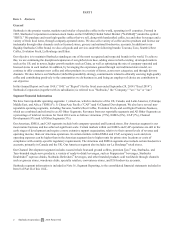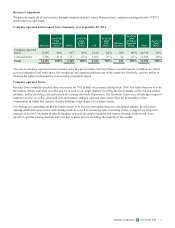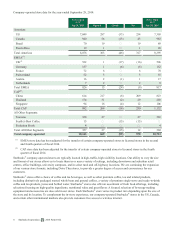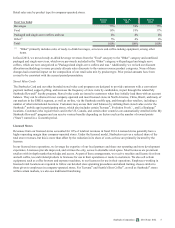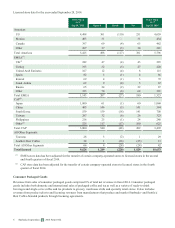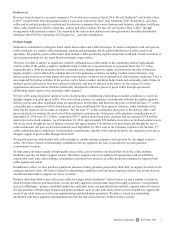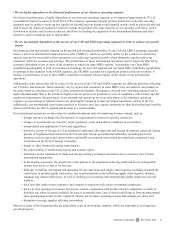Starbucks 2014 Annual Report Download - page 16
Download and view the complete annual report
Please find page 16 of the 2014 Starbucks annual report below. You can navigate through the pages in the report by either clicking on the pages listed below, or by using the keyword search tool below to find specific information within the annual report.
12 Starbucks Corporation 2014 Form 10-K
effects of caffeine or other compounds present in our products, whether accurate or not, or negative publicity or litigation
arising from certain health risks could significantly reduce the demand for our beverages and food products and could
materially harm our business and results of operations.
• We may not be successful in implementing important strategic initiatives or effectively managing growth, which may have
an adverse impact on our business and financial results.
There is no assurance that we will be able to implement important strategic initiatives in accordance with our expectations,
which may result in an adverse impact on our business and financial results. These strategic initiatives are designed to create
growth, improve our results of operations and drive long-term shareholder value, and include:
• successfully leveraging Starbucks brand portfolio outside the company-operated store base, including our increased
focus on international licensed stores;
• focusing on relevant product innovation and profitable new growth platforms, including retail tea, and achieving
customer acceptance of these new products and platforms while maintaining demand for our current offerings;
• continuing the growth of our Channel Development business;
• balancing disciplined global store growth and existing store renovation while meeting target store-level unit
economics in a given market;
• executing a multi-channel advertising and marketing campaign to effectively communicate our message directly to
Starbucks consumers and employees; and
• strategic acquisitions, divestitures or joint ventures.
In addition to other factors listed in this risk factors section, factors that may adversely affect the successful implementation of
these initiatives, which could adversely impact our business and financial results, include construction cost increases associated
with new store openings and remodeling of existing stores; delays in store openings for reasons beyond our control or a lack of
desirable real estate locations available for lease at reasonable rates, either of which could keep us from meeting annual store
opening targets in the US and internationally; lack of customer acceptance of new products due to price increases necessary to
cover the costs of new products or higher input costs; the degree to which we enter into, maintain, develop and are able to
negotiate appropriate terms and conditions of, and enforce, commercial and other agreements; not successfully consummating
favorable strategic transactions or integrating acquired businesses; or the deterioration in our credit ratings, which could limit
the availability of additional financing and increase the cost of obtaining financing to fund our initiatives. If we are not
successful in implementing these strategic initiatives, we may be required to evaluate whether certain assets, including other
intangibles and goodwill, have become impaired. In the event we record an impairment charge, it could have a material impact
on our financial results.
Additionally, effectively managing growth can be challenging, particularly as we continue to expand into new channels outside
the retail store model, increase our focus on our Channel Development business, and expand into new markets internationally
where we must balance the need for flexibility and a degree of autonomy for local management against the need for
consistency with our goals, philosophy and standards. Growth can make it increasingly difficult to ensure a consistent supply of
high-quality raw materials, to locate and hire sufficient numbers of key employees, to maintain an effective system of internal
controls for a globally dispersed enterprise and to train employees worldwide to deliver a consistently high quality product and
customer experience.
• We face intense competition in each of our channels and markets, which could lead to reduced profitability.
The specialty coffee market is intensely competitive, including with respect to product quality, innovation, service,
convenience, and price, and we face significant and increasing competition in all these areas in each of our channels and
markets. Accordingly, we do not have leadership positions in all channels and markets. In the US, the ongoing focus by large
competitors in the quick-service restaurant sector on selling high-quality specialty coffee beverages could lead to decreases in
customer traffic to Starbucks® stores and/or average value per transaction adversely affecting our sales and results of
operations. Similarly, continued competition from well-established competitors in our international markets could hinder
growth and adversely affect our sales and results of operations in those markets. Increased competition in the US packaged
coffee and tea and single-serve and ready-to-drink coffee beverage markets, including from new and large entrants to this
market, could adversely affect the profitability of the Channel Development segment. Additionally, declines in general
consumer demand for specialty coffee products for any reason, including due to consumer preference for other products, could
have a negative effect on our business.
•
Our financial performance is highly dependent on our Americas operating segment, as it comprised approximately of
consolidated total net revenues in fiscal . If the Americas operating segment revenue trends slow or decline our other
segments may be unable to make up any significant shortfall and our business and financial results could be adversely affected.
And because the Americas segment is relatively mature and produces the large majority of our operating cash flows, such a
slowdown or decline could result in reduced cash flows for funding the expansion of our international business and other
initiatives and for returning cash to shareholders.
•
Our future growth increasingly depends on the growth and sustained profitability of our CAP and EMEA operating segments.
Some or all of our international market business units ("MBUs"), which we generally define by the countries in which they
operate, may not be successful in their operations or in achieving expected growth, which ultimately requires achieving
consistent, stable net revenues and earnings. The performance of these international operations may be adversely affected by
economic downturns in one or more of the countries in which our large MBUs operate. In particular, our China MBU
contributes meaningfully to both net revenues and earnings for our CAP segment and our Japan MBU contributes significantly
to earnings in that segment. In the EMEA segment, our UK MBU accounts for a significant portion of the net revenues.
decline in performance of any of these MBUs could have a material adverse impact on the results of our international
operations.
Additionally, some factors that will be critical to the success of the CAP and EMEA segments are different than those affecting
our US stores and licensees. astes naturally vary by region, and consumers in some MBUs may not embrace our products to
the same extent as consumers in the US or other international markets. Occupancy costs and store operating expenses can be
higher internationally than in the US due to higher rents for prime store locations or costs of compliance with country-specific
regulatory requirements. Because many of our international operations are in an early phase of development, operating
expenses as a percentage of related revenues are often higher compared to more developed operations, such as in the US.
Additionally, our international joint venture partners or licensees may face capital constraints or other factors that may limit the
speed at which they are able to expand and develop in a certain market.
Our international operations are also subject to additional inherent risks of conducting business abroad, such as:
• foreign currency exchange rate fluctuations, or requirements to transact in specific currencies;
• changes or uncertainties in economic, legal, regulatory, social and political conditions in our markets;
• interpretation and application of laws and regulations;
• restrictive actions of foreign or US governmental authorities affecting trade and foreign investment, especially during
periods of heightened tension between the US and such foreign governmental authorities, including protective
measures such as export and customs duties and tariffs, government intervention favoring local competitors, and
restrictions on the level of foreign ownership;
• import or other business licensing requirements;
• the enforceability of intellectual property and contract rights;
• limitations on the repatriation of funds and foreign currency exchange restrictions due to current or new US and
international regulations;
• in developing economies, the growth rate in the portion of the population achieving sufficient levels of disposable
income may not be as fast as we forecast;
• difficulty in staffing, developing and managing foreign operations and supply chain logistics, including ensuring the
consistency of product quality and service, due to governmental actions affecting supply chain logistics, distance,
language and cultural differences, as well as challenges in recruiting and retaining high quality employees in local
markets;
• local laws that make it more expensive and complex to negotiate with, retain or terminate employees;
• delays in store openings for reasons beyond our control, competition with locally relevant competitors or a lack of
desirable real estate locations available for lease at reasonable rates, any of which could keep us from meeting annual
store opening targets and, in turn, negatively impact net revenues, operating income and earnings per share; and
• disruption in energy supplies affecting our markets.
Moreover, many of the foregoing risks are particularly acute in developing countries, which are important to our long-term
growth prospects.


